Home
The Chiefs
The Isaac Family
Family Stories
Historical Accounts
Photo Album
Yukon History
Traditional Territory
Culture and Religion
Language
Books and Reference
|
Newspaper Articles
Chief Isaac: The gentle diplomat, HISTORY HUNTER Michael Gates Friday January 25, 2013 Yukon News
|
The Morning Sun, Dawson City, Y.T., Sunday, June 8, 1902
Chief Isaac Sails Today For San Francisco on the Steamer Sarah – Wants to See A Real City
|
The San Fransisco Call, Thursday, July 03, 1902
Busy City Life Pleases Isaac
|
The Morning Sun, Dawson, Wednesday, July 23, 1902
Chief Isaac Due Today
He Had a Grand Visit in Seattle.
Interviewed in That City
|
The Morning Sun, Friday, July 25, 1902
Great Event for Isaac
Tells of the Wonders of San Francisco
He Comes Back Like a Dude
|
Toledo Blade, Toledo, Ohio, Thursday September 18, 1902
A View of the Moosehide Indians Who Were In the Klondike Before White Man
|
The Yukon Sun, Dawson, August 11, 1903
Pioneer McPhee Back in Dawson
|
The Dawson Record, September 13, 1903
Yukon's First Exposition Passes into History
|
The Gazette, Montreal, July 7, 1906
Rival Rainmakers
|
The Evening Chronical, Spokane, Washington, June 17, 1907
Big Potlach on the Yukon
|
Dawson Daily News, August 1, 1907
Dancing Staff from the Great Selkirk Potlach Also Here
|
Dawson Daily News, December 15, 1911
All Yukon Belong to My Papas - Chief Isaac
|
Dawson Daily News, January 2, 1920
War Dance Tonight by Mooshides
|
Dawson Daily News, August 5, 1922
Chief Isaac Pays Repect to Lady Byng
|
The Morning Leader, Regina, Saskachewan, August, 12, 1922
Byng Dines with Miner in Yukon; Also Goes With Them to Bowels of Earth
|
Dawson Daily News, December 1922
Chief Isaac and Tribe Convene and Make Merry
|
Dawson Daily News, March 14, 1923
Strange Tracks In the Snow Near Dawson
|
Dawson Daily News, Tuesday April 03, 1923
Chief Isaac Predicts Four Foot Flood
|
Dawson Daily News, October 13, 1923
Warm In All Part of the Old Yukon |
|
Alaska Weekly, April 15, 1932
Chief Isaac Crosses the Great Divide
|
The Calgary Herald, Friday, November 29, 1940
Yukon Indian Chief to Enlist
|
Vancouver Province, December 20, 1966, Stuart Gray
Civilization? Take it Away!
|
The Whitehorse Star, Thursday, November 10, 1977
Charlie Isaac Went To War - Served All Over Europe
|
The Whitehorse Star, November 8, 1979
George Walters - Yukon Men At War
|
Yukon News, November 10, 2010,
By Joy Isaac
Isaac Fought for Canada, and the Tr’ondek
|
Dawson Daily News Accounts Summary
|
|
Chief Isaac: The Gentle Diplomat HISTORY HUNTER Michael Gates Friday January 25, 2013 Yukon News HISTORY HUNTER Michael Gates Friday January 25, 2013 Yukon News
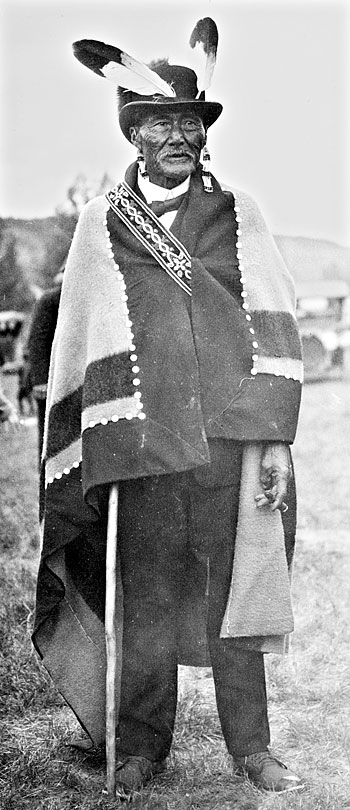
|
He greeted visitors who arrived in Dawson on the riverboats in the
early days. He met royalty and represented his people on many special
occasions throughout the territory. He was the gentle and dignified
emissary who bridged the gap between two cultures.
He was Chief Isaac, the leader of the Moosehide band near Dawson City.
Chief Isaac was probably born around 1847, most likely, in the upper
Tanana country south of the Fortymile district in Alaska. That was at a
time before there were real boundaries between Alaska and British North
America. He spent his younger years in the Fortymile area and moved to
the mouth of the Klondike after marrying Eliza Harper. Four of their
children survived into adulthood.
During the winter of 1897-98, Dawson City fell desperately short of
food. Hundreds had fled the newborn town in the fall before the Yukon
River froze, but still it wasn’t enough. Meat, if it was available at
all, was selling for 30 times the price that it fetched Outside.
|
Chief Isaac led his villagers up the Klondike valley to its extreme
reaches, where they were able to bag 80 moose and 65 caribou, which
eased the hardship in Dawson immeasurably. With the proceeds, they were
able to invest in finery, repeating rifles, and presumably, food from
the Alaska Commercial store.
Chief Isaac lived during the Klondike gold rush when his community was
subjected to more social change in a short time than any other First
Nation in the country. He served as an important link between the old
ways and the new. He was probably the right man to lead the Han people
into the 20th century.
He could see at the very beginning of the gold rush what a profound
impact it would have on his people, so he engineered the move a short
distance to the village of Moosehide, which survives today and holds
much meaning for the Tr’ondek Hwech’in in Dawson.
Chief Isaac represented his people at every occasion when the two
cultures met, and he handled these events with great diplomacy and
patience. His message was always the same:
“Long time ago before the white man come along Yukon Indian was happy.
Indian had plenty game, no trouble and was fat. White man comes and
Indian go out and kill meat to feed him. Indian give white man clothes
to wear and warm him by Indian fire. Byemby ... million white man come
and cut down Indian’s wood, kill Indian’s game, take Indian’s gold out
of ground, give Indian nothing. Game all gone, wood all gone, Indian
cold and hungry, white man no care.”
The core message that he repeated with regularity at every opportunity
was to remind the newcomers, the Europeans, that it was his people’s
land onto which they were welcomed. They were welcome to the gold, but
they should leave the fishing and hunting to the natives. Sadly it
didn’t happen that way.
In 1902, he embarked on a long journey to San Francisco and Seattle,
sponsored by the three Dawson trading companies. His aim was to improve
his health (he is reported to have been suffering from consumption),
and to become better informed about life on the Outside.
He departed Dawson dressed in newly tanned moose skin apparel covered
in decorative beadwork and velvet stripes, topped off with a cap and
several tall feathers. His goal was to tell the white people how “his
people and the whites were brothers, and the Indian women and the white
women were sisters.”
Having endured constant bouts of sea sickness, he arrived in San
Francisco with his younger brother, Walter. He was shown all the
sights. He rode in an elevator for the first time, took a ride in an
amusement park, and visited the zoo. He was amazed that the moose would
come to the fence and take sweets, rather than run away!
During his stay in San Francisco, Yukon veteran Jack McQuesten was his
guide for a day. Speaking in Isaac’s native tongue put him at ease
during their short visit together. Isaac took his first train ride on
the journey from San Francisco to Seattle, where the NAT&T Company
representative showed him around. Talking to the Seattle
Post-Intelligencer newspaper, he tactfully, but bluntly stated: “While
the coming of the white man killed our business or trading, fishing and
hunting, yet we are glad to have him on the Yukon.”
Six weeks after departing, his health apparently restored, he arrived
back in Dawson aboard the steamer Zealandian, dressed to the nines.
Upon his head now was a stylish new hat. Beneath his suit he wore a
beautifully striped muslin shirt with sparkling white collar and a
brightly coloured tie. In his right hand, he sported a cane, while in
his left hand, he carried a satchel filled with souvenirs. A couple of
days after his return, the entire community convened in his Moosehide
cabin to hear his account of his visit to the outside world.
Members of the white community were entertained by traditional dances
at events in Dawson, as well as at proceedings at Moosehide. Chief
Isaac always presided, dressed in his formal regalia. These events
afforded him the opportunity to deliver his message about the European
impact upon his community, usually followed by everyone present
removing their hats and singing “God Save the King.”
He was the spokesman who intervened on behalf of Han members who were
convicted of minor offences, and he represented them when petitioning
for jobs or seeking assistance from the government. He was actively
involved in the business of the Anglican Church in Moosehide, but
maintained a careful balancing act with traditional spiritual beliefs.
In 1922, he was introduced to Lady Byng, wife of the governor general.
Dressed in beaded moose skin from head to foot, he talked to her for a
short while, and then presented her with some fine leather crafts from
the people of Moosehide. It was one of his last documented official
functions.
Chief Isaac died of influenza on April 9, 1932, at 85 years old. He is
remembered fondly by the Tr’ondek Hwech’in of Dawson. Chief Isaac Hall
is named in his honour. Mount Chief Isaac is located in the Ogilvie
Mountains north of Dawson. Dawson residents even made him an honorary
member of the Yukon Order of Pioneers.
Michael Gates is a Yukon historian and sometimes adventurer based in
Whitehorse. His new book, Dalton’s Gold Rush Trail, is now available in
stores. You can contact him at msgates@northwestel.net
Chief Isaac's Trip to San
Fransisco
One of the notable events in the life of Chief Isaac was a trip he took
from Dawson to San Francisco in 1901 as a guest of the Alaska
Commercial Company. This free trip was by steamboat to the mouth of the
Yukon and then by steamship from St. Michael to Seattle and San
Francisco Bay. Accompanying him, according to Louise Paul, were the lay
reader Walter Benjamin and the Han medicine man Little Paul. Although
he got seasick both ways, Isaac returned to Dawson standing on the
Texas deck of the steamer 'Whitehorse', wearing a high hard hat,
speckled knickers, a bright red tie with a sparkling pin, and sporting
a big Havana cigar in his mouth. The newspapers reported that he was
greeted by a crowd of thousands.
The Morning Sun, Dawson City, Y.T., Sunday, June 8, 1902
Chief Isaac Sails Today For San Francisco on the Steamer Sarah – Wants to See A Real City
Advised to Beware of Girls Whose Mamas Were Kissed by Great Men,
Extinguishing the Gas With Fire Apparatus and Shooting Geese in Park.
When the steamer Sarah sails this afternoon it will have on board Chief
Isaac, who goes on a tour of the Pacific sates at the invitation of the
commercial companies.
Isaac wants to see what the country outside is like; wants to see the
animals that he sees in pictures, to see the big wigwams the white man
lives in, and all the other things which this wise age of the far north
has noticed in illustrations and heard of in descriptions. He has
practiced on a yell with which to scare the “kids” on the outside, and
practiced on a few kids in South Dawson yesterday and almost frightened
them into hysterics, but was highly pleased with the result.
Isaac will have his son Walter, who is at Forty-Mile, accompany him as
interpreter, private secretary and keeper of the sacred fox tail.
So there will be weeping and wailing tonight in the camp of the
Moosehides after Chief Isaac starts for the land of the white
man. But before he goes a friend would like to give Ike a tip:
“At all times keep your hand on your poke,” he says. “Always wait
for the car to stop before getting on or off. All that glitters
is not gold. Don’t buy anything except your meals. When the car
gong rings, stop still. If you start to dodge you’ll hit the
car. When any stranger shakes hands keep him at arm’s
length. Remember all the friends you know. Pay no attention
to all the friends who remember you. There are lots of Indians in
the cities you will visit, but they don’t wear the same clothes and are
white. “And above all, Ike, heed this warning: Don’t, under
any circumstances, have anything to do with any vemons.’ They
always cause men to come back C.O.D. With this bit of advice the
entire community wishes you a hearty trip, but prophesies that when you
once more reach home you’ll want to stay here forever.”
The San Fransisco Call, Thursday, July 03, 1902
Busy City Life Pleases Isaac
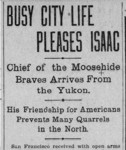
The Morning Sun, Dawson, Wednesday, July 23, 1902
Chief Isaac Due Today
He Had a Grand Visit in Seattle.
INTERVIEWED IN THAT CITY

Click for article.
While
White Men Have Killed the Business of the Indians in Trading, Fishing
and Hunting He is Still Glad to Have Them in the Yukon. It is stated that Chief Isaac will be back in Dawson today and that he will arrive on one of the mail steamers this morning. The
visit of Chief Isaac in Seattle has brought forth the following account
of him and his people in the Post-intelligence of that city: “While
the coming of the white man have killed our business or trading,
fishing and hunting, yet we are glad to have him on the Yukon.” So
spoke Isaac, chief of the Moosehides, a tribe once powerful and which
had for ages occupied the Yukon. The noted red—for there is none other
in all Alaska and the British Yukon so well known and so beloved both
by the whites and natives—is in Seattle on his way north. Late in May
he left Dawson, going down the Yukon, where at St. Micheal he took the
steamship St. Paul for San Francisco. From this city he will return
north Santa Ana, sailing today. The chief is accompanied by Walter
Isaac, a younger brother. He is not an old man, only forty,yet he is
wise in counsel and his influence with the Yukon Indians in undeniably
great. The chief was born at the mouth of the famous Klondike. As a
papoose strapped across his mother's back, he was carried all over the
golden ground about Dawson. H wallowed in the auriferous sands and ate
smoked salmon for food. Walter, ten years later, made his advent on the
Yukon. He is an American by birth, for he first saw the light of day at
Eagle City. The chief is British. But they are brothers in blood, if
not in nationality. Both speak English. Walter better, perhaps, than
his brother. Isaac knows of his own
knowledge that his father was chief by tradition that his ancestors
were chiefs of the Moosehide for ages and ages. But of all the heads of
the tribe there was probably not a greater man than the present chief.
Certainly he is more advanced in civilization. Chief
Isaac left the Yukon on his present tour in quest of health and to
better inform himself of the manner and methods of the up-to-date
civilized man. He was threatened with consumption, but the trip has
almost restored him to health. The Northern Commercial Company, the
Alaska Commercial and the North American Transportation & Trading
Company gave him transportation from Dawson to San Francisco and the
latter transportation is entertaining him in this city and aiding him
in his return to the Yukon. R,D. Snowden, manager of the latter
company, is caring for the chief's comfort and entertainment here. “I
feel gratitude to the big companies,” he said, for what they have done
for me. My health is much better and I have seen a great deal.” Here
the chief paused a moment and smilingly added: “Yes, I have seen so
many strange and great things that I am tired now and want to return to
my people.” “The white man, it is
true, drove our moose and other game back into the mountains out of our
reach , but it is probably best for us. The cold of the earth is
telling on us. Even the Moosehides can't stand that awful climate as
they once could. They are dying off. My tribe now numbers but about 50
all told.” “No, we have never mined.
We don't believe in mining. Our pursuits have always been trading and
hunting and fishing. Sometimes we mine for gold, but not often.” On
the streets of Seattle Chief Isaac met “Black Sullivan”. It was a
joyous meeting. The two are great chums. “Black” Sullivan was one of
the very first men on the Yukon. He, of course, came to know the chief
well. In all the latter's travels he had seen no one with whom he was
so well acquainted. Sullivan is a heavy Yukon operator. He resides in
Seattle.
The Morning Sun, Friday, July 25, 1902
Great Event for Isaac
Tells of the Wonders of San Francisco
He Comes Back Like a Dude
Moose and Caribou in Park Do Not Run from Him – Elevator Frightens and Tunnel Terrifies Him - Chaperoned by McQuestin.
Chief Isaac, chief of the Moosehides, duke of the Yukon, barren of
money, etc., etc., chief defender of his title, etc.,etc., returned
Wednesday from a pleasure tour of the Pacific coast cities. With the
usual pome and ceremony which accompanies royalty, Isaac was the
recipient of the reception such as is seldom given to anyone.
When the Zealandian pulled up to the wharf, Isaac stepped to the rails
and gazed in admiration at the crowd of Indians, both white and red who
had congregated to give him welcome. The band boys were on the
landing place without their instruments. “Hail to the Chief” was
not played. Isaac smiled and so did the crowd. He was glad
to see so many present. They smiled at Isaac’s
make-up. He had left Dawson looking every inch a
chief. He returned looking like Sheldon Jackson’s secretary, with
his cheechaco checked clothes. His hat of the latest block
from Dunlap, tie of the brightest hue, white collar, beautifully
striped muslin shirt, a suit made by the “Six Little Tailors” or some
other bunch of artists. He wore a cane in right hand and shoes on
his feet , while in his left hand was a grip. The grip was full
of souvenirs. His heart was full of gladness and his mind full of
the many strange things he had seen.
Everybody called out a welcome to the chief. He smiled and
pulling a serious look down over the map of Moosehide, said in a
phonographic voice:
“Gemmen: I’s glad get back my country – Yukon. Outside the
fine place. I have good time. Yukon lots of gold, all
right. Outside just place to spend money. I’m happy I’m get
back. Have big time San Francisco. Big time Seattle; everywhere.
I see ‘em. I tell Moosehide Indian. N.C., he him big.
N.C. all same God. All same God to me. Him man N. C.
Company make me just like white man outside.”
When Isaac left here on the Sarah he asked that the boat be slowed down
at Moosehide. It was done. Isaac stood on the boiler
deck and watched with interest what his handiwork had built from
one cabin to fully fourteen. As the other passengers looked for
some display of enthusiasm from the village they were greeted with the
sIght of all the village bucks, dressed in blankets, coming from behind
on of the cabins. Down to the bank they came, and Indulged in
some kind of wild dance. Then suddenly they pulled guns from
under their blankets and began firing. Everybody thought it was a
salute, and Isaac lifted his hat in response to the honor. But
the Indians were firing straight at the Sarah. Bullets whistled
over the hurricane deck. Passengers rushed to the Inside of the
steamer, pilots laid flat in the wheelhouse and Manager Mizner sought
safety behind one of the smokestacks. A pilot cautiously rang for
full speed and securing a glance at the river steered for the middle of
the river.
Toledo Blade, Toledo, Ohio: Thursday September 18, 1902
A View of the Moosehide Indians Who Were In the Klondike Before White Man
North Dawson, Showing the “Slide.” Moosehide Lies Back of the Mountains.
Before gold was discovered in the Klondike and its tributaries, the
Moosehide Indians inhabited the country. They were a healthy,
stalwart tribe, brave and prosperous. Winters they hunted
and trapped, and their traffic in furs was considerable. The
Yukon supplied them with fish and forests furnished them with fuel and
shelter. They did not know gold, but decorated themselves and
their dogs with pretty nuggets, ignorant of their value.
In features they somewhat resembled the Japanese, but in stature they were far superior.
For years they were ruled by Chief Isaac, who, according to Indian
reckoning, reached the age of one hundred and eighty years. At
the time of his death, which occurred several years ago, he left two
sons. The elder, the present Chief Isaac, was born at the mouth
of the Klondike, near the present site of the city of Dawson, and so he
boasts of being a subject of King Edward. His little son, is
named Edward for that reason. But the younger brother, Walter,
who speaks English with ease, is proud because he is an American
citizen, having been born at Eagle, Alaska.
The two brothers have just returned from a visit to San Francisco and
other coast cities, where they have been sightseeing in true tourist
style. They enjoyed the trip immensely, except the sea sickness,
which afflicted them on the ocean voyage. However, they seemed to
regard their unpleasant experience with all the humor of a white man.
On his return to Dawson, chief was given a reception by the citizens,
and all of the Moosehides were present. As he neared the place of
his birth, his emotions were intense, and he clasped the little Edward,
who was the first to greet him, with all the fervor of a loving
father. When he departed, his people were disposed to believe
that he would never return, and the grief of “Bowlegs” his wife, was
pitiful.
During the few years that have elapsed since gold discoveries, the
tribe has succumbed to disease, principally consumption, until only a
small number, no more than fifty all told, remains.
Two miles down the river from Dawson, or over the “Dome” if you follow
the trail, is Moosehide, the Indian village. The people have
cabins similar to the whites.
Chief Isaac resides in a roomy log cabin, over which a large Canadian
flag floats. His wife, whose real name is Eliza, is a fairly good
housekeeper. The furniture, except the chairs, is homemade.
A modern cooking stove occupies one corner, and pictures, nicely
framed, of the old queen and the new king, adorn the walls, together
with guns, eagle feathers and other characteristic decorations.
The Yukon Sun, Dawson, August 11, 1903
Pioneer McPhee Back in Dawson
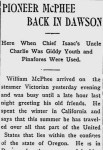
Click here for article.
The Dawson Record, September 13, 1903
Yukon's First Exposition Passes into History

Click here for article.
The Gazette, Montreal, July 7, 1906
Rival Rainmakers
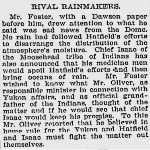
Click here for article.
The Evening Chronical, Spokane, Washington, June 17, 1907
Big Potlach on the Yukon
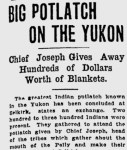
Click for article.
Dawson Daily News, August 1, 1907
Dancing Staff from the Great Selkirk Potlach Also Here

Click here for article.
Dawson Daily News, December 15, 1911
All Yukon Belong to My Papas - Chief Isaac
It was the Klondike gold rush that brought thousands of gold
seekers to the Klondike region beginning in 1896. This made the Han
people a small minority of some hundreds of people, compared to the
hundred thousand invaders. The leader in those difficult times was
Chief Isaac. He resisted the destruction of the traditional ways,
opposed against the destruction of the natural resources, especially
against overhunting the caribou herds and the destruction of the
forests.
Chief Isaac quoted in Dawson Daily News, December 15, 1911.
"All Yukon belong to my papas. All Klondike belong my people. Country
now all mine. Long time all mine. Hills all mine; moose all mine;
rabbits all mine; gold all mine. White man come and take all my gold.
Take millions, take hundreds fifty millions, and blow'em in Seattle.
Now Moosehide Injun want Christmas. Game is gone. White man kills all
moose and caribou near Dawson, which is owned by Moosehide. Injun
everywhere have own hunting grounds. Moosehides hunt up Klondike, up
Sixtymile, up Twentymile, but game is all gone. White man kill all.
Dawson Daily News, January 2, 1920
War Dance Tonight by Mooshides

Click here for article.
Dawson Daily News, August 5, 1922
Chief Isaac Pays Repect to Lady Byng

Click for article.
The Morning Leader, Regina, Saskachewan, August, 12, 1922
Byng Dines with Miner in Yukon; Also Goes With Them to Bowels of Earth
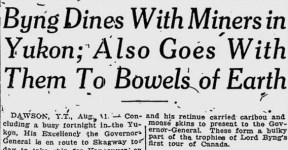
Click for article.
Dawson Daily News, December 1922
Chief Isaac
and Tribe Convene and Make Merry
Starting last Thursday night with a Christmas Eve celebration
the
little Indian village of Moosehide has been a busy place during the
last few days with potlatches and good times. And the end is not yet at
hand. All during this week the celebration will continue until next
Monday night, when a final Christmas tree and potlatch will bring the
holiday festivities at Moosehide to an end for another year.
Last Thursday night the Indians gathered together around a big
tree in
one of the houses where presents and good eats were freely disbursed to
all in attendance. Chief Isaac was the guest of honour, while Charlie
Mason was the Christmas boss and looked after all the arrangements.
Chief Isaac states that everybody was happy and that the Indian boys
and girls and men and women all had a "heap good" time . Lots to eat.
Mountain sheep, candy, fruit, and plenty to smoke. Then there were
songs and speeches. Jimus Francis was there as big as life and when
called upon to contribute to the gaiety, Jimus stood up and with his
ever present grin the young Peel River brave made a great speech. Chief
Isaac also made a great spiel to his tribe in which he told his
followers to have a good time but warned them not to drink any
"firewater". The chief says that Christmas this year in the Yukon has
been the best he has known for a long time. "I go to Pioneer dinner on
Christmas afternoon." said the chief; "have fine dinner, lots to smoke,
also tell Pioneers all about Christmas here, white man come. Well, me
busy man these days. Must go now. Good bye now. Thanks for smoke. "
Dawson Daily News, Wednesday, March 14, 1923
Strange Tracks In the Snow Near Dawson
Chief Isaac Sees Huge Imprints Which Cause A Sensation
Animal Is Not Sighted
Many Speculations As To Its Size – May Be Long Lost Diplodocus
Chief Isaac, of Mooshide, the Montezuma of the Klondike, who owned all
the Klondike before the whites came and took out the two hundred
million in gold, and who is still holding the sack and bagging game
whenever he has a chance, was out on the Glacier ridge trail last week,
and saw a mammoth new track which was given him all kinds of new
thrills, and the news of which has spread a sensation among the
moosehide braves and belles.
“Me see’m track out there big lika dat-“ says the chief. “Then he
takes his two fists and makes sharp imprints in the snow, with his
whole arm also making an impression all the way to the elbow, thus
indicating it was a monster whose track the chief crossed.
“Seven miles out me see’m track,” says the chief.”
“Nope, me no know what call’m. Maybe some new kind wild animal –
maybe mountain lion. Me never see that kind here before, my
father never see, my grandfather never see.
“Three years ago coyote come to Yukon for first time; now maybe some other wild animal come. I dunno.”
At first there was much excitement in Dawson in certain circles when
the report of the chief’s discovery was made. Alairie Seguin
began to plan on chances to buy a pelt that would cover a warehouse,
and some of the boys thought the animal might be the original
Kickabrewsaurus or second cousin to the giganticus diplodocus, about as
tall as the ferry tower, which once roamed the land, and which Georges
Dupuy, once editor of the French page on the Dawson News, and others
once sighted near Clear creek, on the Stewart river, and which they are
now tracking through Siberia. The animal last reported
doubling back from mid Siberia, probably afraid of the Red Terror No
definite report of his movements have been received the last few days.
The chief, however, vouches he never saw such a track in all these
parts no never heard of such, and, as the chief does not know the trail
to the G.L.S. and does not believe in moonshine or other beverages than
tea, his report is given full credence.
Dawson Daily News, Tuesday April 03, 1923
Chief Isaac Predicts Four Foot Flood
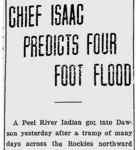
Dawson Daily News, October 13, 1923
Warm In All Part of the Old Yukon

Click for article.
Alaska Weekly, April 15, 1932
Chief Isaac Crosses
the Great DivideLoved and Esteemed Yukon Indian Chief Was Honorary Member Yukon Order
of Pioneers
Chief Isaac, Montezuma of the Klondike, was called to the happy hunting
grounds last week. He breathed his last at the village of Moosehide, on
the banks of the Yukon river three miles below Dawson, and his remains
were recently laid away in the little Indian burial ground on the
hillside overlooking the village.
Born some 85 years ago, Isaac was elected chief as a young man, and
through many years of trial before and after the coming of the
whiteman, proved his worthiness for the honor and trust imposed in him
by his people.
Tall, slender, sinewy and muscular, he was of superior physical
proportions, and time also proved him as well endowed mentally. His
friendliness to the whites, dating back to the days of the Russian
occupation of the Yukon and Alaska, and his influence with other
Indians, went far toward smoothing the way for prospectors, traders,
trappers, missionaries and others who pioneered the Northland. Those
who knew Chief Isaac well agree, that, had he been a white man with
opportunities for education, combined with his natural ability and
personality, he would have proved to be an extraordinary figure in most
any walk of life.
Camped On Untold Wealth
The Moosehide tribe, of which the chief was the head for many decades,
held by inheritance all the interior area of Yukon between the
Fortymile and the Stewart rivers. This area included the world famed
valley of the Klondike and its wondrous network of gold-bearing creeks
which yielded to the world a quarter billion dollars or more in gold
and are still producing at the rate of a million dollars per annum.
The chief, like all other members of his tribe, was a devout member of
the Church of England. He was a faithful attendant at services in the
little church at Moosehide-founded by Rev. Archdeacon MacDonald,
translator of the Bible into the Takudh Indian language, which is the
language of the Moosehide tribe. The Rev. Totty and Bishop Bompass,
also were identified with the little church through many years since it
was established.
For centuries all of the wealth of the Klondike lay within the radius
of a days hike from the home of Chief Isaac and his people, yet,
endowed with the wealth equal to the ransom of a score of kings, they
knew not of its existence or its value until the white man came. The
Indians practically gained nothing from that great store of golden
treasure and even after the strike they lived the simple life of the
native within the shadow of the great gold camp and Dawson it's capitol
city.
Isaac was made honorary member of the Yukon Order of Pioneers some
years ago, and on Discovery and other celebration days always accorded
a place of honor at the head of the various pioneer parades and sat
with the big white tillicums at the banquet board. He was a great
chief...and although his skin was red, his heart was white--and not a
sourdough of that vast throng who passed his way fails to hold a kindly
thought for him today, and silently and sincerely say unto themselves,
"he was a friend to the whites in a far land...what's more he was every
inch a man."
Chief Isaac leaves two sons and two daughters to mourn his loss. One of
his sons will possibly be made chief in his stead. At present time
there is quite an epidemis of influenza among the Indians along the
upper Yukon. Chief Isaac was a victim of that dread malady.
The Calgary Herald, Friday, November 29, 1940
Yukon Indian Chief to Enlist
Prince Rupert, B.C., Nov. 29 (CP)
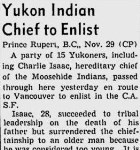
Click for artcle.
A party of 15 Yukoners, including Charlie Isaac, hereditary chief of
the Moosehide Indians, passed through here yesterday en route to
Vancouver to enlist in the C.A.S.F.
Isaac, 28, succeeded to tribal leadership on the death of his father
but surrendered the chieftainship to an older man because he was
considered too young. It is the first time he has left the
Moosehide reservation near Dawson.
Vancouver Province, December 20, 1966, Stuart Gray
Civilization? Take it Away!
Chief Charlie Isaac leaned forward on the chair 735 miles from home and
smiled. "If I met some of the long haired people from Robson Street in
the bush up north," he said, "I'd run. That is, unless I carried a
tomohawk."
Home for Charlie, 56 year old head of the Moosehide Band from Dawson
City in the Yukon, is a cabin in the deserted village of Moosehide, two
rugged miles from Dawson. His 200 band members moved from the village
when the Federal government supplied them with modern homes,
electricity and running water. But Charlie is an individualist. He's
content to drink mountain creek water, stoke the fire with pine wood,
and share the solitude of the forest with his older brother Fred, 64.
Right now he's staying in New Westminster for a few weeks while being
treated for arthritis as an outpatient at Shaughnessy Hospital. With
the evening rain battering the roof of his boarding house, and still
half-an-hour until bedtime, he shifted his chair and settled back.
At first glance, Charlie seems just an ordinary chief, with erect
bearing, finely hewn features, and wise eyes-the usual chieftain
qualities. His air of authenticity deepens when he tells of setting
traps at the age of 12, or of wolves that prowl around his cabin in
winter. This picture soon shatters. Chiefs aren't usually expected to
have a spontaneous sense of humor that erupts every other sentence.
They aren't expected to have been overseas during the Second World War,
and to have slept in English cottages, French inns, Dutch cots, or
Italian vineyards. They aren't usually regarded as confirmed bachelors
with erudite opinions on modern social structures. This, however, is
Charlie; humorist, war veteran, and philosopher, who chose to live in
the bush just as generations did before him.
He began trapping with his father in 1922, and was skilled in woodlore
before the elder Isaac decided another sort of skill was needed. "I
didn't want to go to school, but my father made me," Charlie said. "As
it turned out, I did five years of school in three. Then I left school
and went back to trapping with my father."
Charlie trapped for another dozen years, during which time he became a
confirmed bachelor. Then, with his parents dead and no dependents, he
left Moosehide to join the army and see the world.
The artillery regiment on Vancouver Island was happy to accept the
strapping young chief, but Charlie became unhappy with the regiment. "I
didn't like the artillery guns. They were pretty big, and sure hard on
your ear drums. I joined the Royal Canadian Ordinance Corps in1942 and
went back East."
During the next three years, he criss-crossed Europe, and saw action on
many fronts as an ammunition bearer. More than one hard-pressed machine
gunner in the heat of battle was startled to receive his clips from a
real Indian wearing Ordinance flashes.
Two Christmas Days of the war were spent by Charlie in Italy, one of
his favorite countries. He recalls some unusual sleeping accommodation.
"We used to lie down and go to sleep between rows of grapes in the
vineyards. All around us would be a cloak of grapes." The abundance of
grapes--and wine--sometimes provided an opportunity for intrigue. "The
Germans used to put poison in the vats, which were huge, great things.
The Canadians used to test the wine by letting a cat drink it first."
After the war, Charlie landed in Halifax, where he was greeted by a
bevy of pretty girls bearing flowers and candy. He lost no time in
getting back up north.
Although he hasn't trapped since the war, he regularly walks the two
miles into Dawson for exercise. He is still well-known to members of
his rapidly-growing tribe. "Even the little kids come up and call me
chief. There are so many of them, I scratch my head." Shopping and
visiting over, Charlie returns to his cabin. "On a cold night with
strong moonlight, you can look out and watch the wolves howl."
The Whitehorse Star, Thursday, November 10, 1977
Charlie
Isaac Went To War - Served All Over Europe
Late in 1941, Charlie Isaac, who had succeeded his father as Chief of
the Moosehide Indians ten years before, handed over the tribe to a
council of elders and quit his job with White Pass to go to war.
Accompanied by George Walters, he joined the Army in Vancouver and
found himself with an artillery regiment on Vancouver Island, taking a
signalling course in Victoria.
But, he said, "I didn't like the artillery guns. They were pretty big
and sure hard on your ear drums. I joined the Royal Canadian Ordinance
Corps in 1942 and went back East."
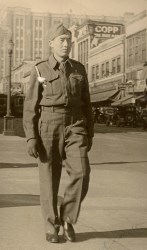
Charlie Isaac, Vanouver, 23 March 1942
There was Sapper Charlie Ross, who had just returned from six months at
York Island; Private George Maddocks of the Royal Canadian Army Medical
Corps attached to Shaughnessy Hospital in Vancouver; Privates Henry
Siemers, distinguished by his number K-1000000, Axel Nordling and Ian
Aldcroft enroute to training camp; Privates Otto Nordling and Alan
Gould of the Hotel Vancouver barracks staff, Corporal Tommy Rodgers,
based at Stanley Park and Dan Olds who had just received his discharge.
From Aldershot, England, Charlie served as an ammunition-bearer all
over Europe and in Italy of which he wrote, "We used to lie down and go
to sleep between the rows of grapes in the vineyards. All around us
would be a cloak of grapes. The Germans used to put poison in the wine
vats, which were huge, great things. The Canadians used to test the
wine by letting a cat drink it first."
He spent two Christmases in Italy, joining the other homesick Canadians
in singing, to "White Christmas."
Charlie's wartime and other stories were featured in an article
"Civilization? Take it Away" by Stuart Gray in The Vancouver Province
(Dec.20,1966 carried by the Whitehorse Star on the 22nd).
It was read by General J.V. Allard, Canadian Forces Headquarters Ottawa
who wrote Charlie a personal note.
It read, in part, "Your a real credit to Canada and an inspiration to
your tribe; I salute you and pray to God that he keep you for many
years to come..."
The Whitehorse Star, November 8, 1979
George Walters - Yukon Men
At War
Note: George Walters grandmother is Ellen Silas. His mother is
Eva Silas.
George Walters left Dawson City a month after Charlie Isaac,
joining the Canadian Forestry Corps in December 1940 for training at
Valcartier, Quebec. Part of General Crears 1st Canadian Army, Georgies
whole division went to Europe on the "Pasteur" a fast French single
stacker, traveling in convoy from Halifax to Scotland, escorted by the
biggest British battleships including the "Renown".
Posted to a forestry camp near Inverness, Scotland Georgie cut
railroad
ties and drove 'cat' alongside Australians, New Zealanders and
Newfoundlanders, and kept an eye peeled for enemy paratroopers.
The Dawson boys were soon split up, he remembers, but
curiously they
met at odd times, even in the heat of battle, when the first words
were, "how much smoke you got," and they shared the packs or cartons of
Sweet Caps or Players sent from home.
In 1942-'43 when the Canadian Army were re-taking Norway,
George
Walters was hit by a shrapnel and was returned to Canada on the "Lady
Nelson". A hospital ship, she traveled all lit up, with spotlights on
the big Red Cross on her side and decks. Later in the war, even
hospital ships were not safe from submarine attack.
Yukon News, Wednesday
November 10, 2010, By Joy Isaac
Isaac Fought for Canada, and the
Tr’ondek
Charlie Isaac was born November 25, 1912, in Moosehide Village, a short
distance downstream of Dawson City. He was the son of the beloved Chief
Isaac and his wife Eliza. Chief Issac led his people through the
upheaval of the Gold Rush and passed away in 1932. Charlie succeeded
his father as chief of the Han Nation (Tr’ondek Hwech’in) when he was
20. When the Second World War began, Charlie handed over his role as
chief to a council of elders and headed to Vancouver in 1941 to join
the army and fight for his country. He was accompanied by George
Walters.
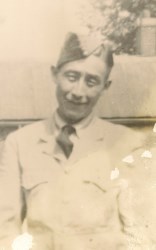
Charlie Isaac, Italy 1944
While stationed at the old Hotel Vancouver barracks in April 1942, and
after graduating in motor mechanics at the Vancouver Trade School,
Charlie reported he’d met up with a happy crowd of Yukon soldiers
enjoying the sunshine in front of the old hotel, including Sapper
Charlie Ross, privates George Maddocks, Henry Siemers, Axel Nordling,
Ian Aldcroft, Otto Nordling, Alan Gould, and corporals Tommy Rodgers
and Dan Olds.
Soon Charlie found himself with an artillery regiment on Vancouver
Island and taking a signaling course in Victoria. “I didn’t like the
artillery guns,” he said. “They were pretty big and sure hard on your
ear drums. I joined the Royal Canadian Ordnance Corps in 1942 and went
back east.” After training, he was sent overseas and served as an
ammunition bearer, seeing a lot of action on fronts throughout Europe.
He slept in English cottages, French inns, Dutch cots or Italian
vineyards. “We used to lie down and go to sleep between the rows of
grapes in the vineyards,” Charlie said. “All around us would be a cloak
of grapes. The Germans used to put poison in the wine vats, which were
huge, great things. The Canadians used to test the wine by letting a
cat drink it first.”
Charlie’s wartime and other stories were featured in the article
Civilization? Take it Away by Stuart Gray in The Vancouver Province,
December 20, 1966.
When the war ended in 1945, Charlie returned home to Yukon and carried
on as chief, devoting his time to working with government to improve
the condition of his people. He had a great sense of humour and, more
than once, told government officials the government had stolen the land
from his people and he had gone to war to save the land for them. His
200 member band was moved from Moosehide village so they could be
supplied with modern homes, electricity and running water. However,
Charlie preferred to drink mountain creek water and decided to move
back to the old village and share the solitude with his older brother
Fred.
Charlie’s health eventually deteriorated from an overseas bout with
malaria. He also suffered from a serious arthritic condition which was
probably caused from lying in one too many muddied battlefield ditches
while serving overseas. The war years eventually took its toll and
Charlie moved to George Derby Veterans Centre in Burnaby where he
passed away suddenly on February 25, 1975, at the age of 63. He was
laid to rest in cemetery above Dawson City. Charlie was adored by many
people in his village and will always be missed by family.
Charlie’s medals include the 39-45 Star, Italy Star, France and German
Star, Defense Metal and Volunteer Service Medal and clasp. Joy Isaac is
the niece of Charlie Isaac.
Dawson Daily News Accounts Summary
1897-After Chief Isaac negotiated with government and church officials,
the Tro'ndek Hwech'in moved downriver to Moosehide. They built cabins
for missionary and themselves.
1902-Chief Isaac travels Outside on a trip to visit various major
coastal cities sponsored by the major trading companies. Chief Isaac
and his brother Walter are the guest of the three major trading
companies on a trip to San Francisco. They travel downriver on steamer
Sarah.
1913-"Young Prince of Moosehide Off To School." Fred Isaac and 7 other
Moosehide children leave for school in Carcross.
1922-Young Charlie Isaac began trapping with his father and was skilled
in woodlore before the elder Isaac decided another sort of skill was
needed. "I didn't want to go to school, but my father made me," Charlie
said. "As it turned out, I did five years of school in three at
Carcross. Then I left school and went back to trapping with my father."
June 22, 1926- Big Chief is Back from Selkirk
Chief Isaac, powerful Montezuma of the North returned by small boat on
Thursday afternoon from Selkirk, where he had been paying a visit
during the last three weeks. Bronzed and rugged looking from his
vacation out in the open, the big chief is in pink of condition. The
Chief said that everybody was glad to see him in Selkirk. He said that
the white men and the Indians shook hands with him. He said that all
had a big time.
On the way down the river Isaac stopped off at Coffee Creek, where
another big potlatch was held among the Indians at that point. The
chief also bagged two moose and stopped at several other places while
on his way down the river. Chief Isaac was accompanied on his jaunt to
Selkirk by Johnathon Wood and Esau Harper.
1932-death of Chief Isaac during influenza epidemic.
1938-Death of Johnathan Wood, brother of Chief Isaac, described as
"easily the oldest Yukon Indian resident at Moosehide" (Jan. 6,1938)
1939-outbreak of World War 11. Eventually a number of Yukon First
Nations enlist to serve overseas including Charlie Isaac, son of Chief
Isaac. George Walters left Dawson City a month after Charlie Isaac,
joining the Canadian Forestry Corps.
1942-Charlie Isaac, "young chief of the Moosehide braves" recently
transferred from Victoria. Will be stationed in Vancouver while
studying mechanics. In Victoria, took a course in signalling and
finished with flying colours.
|
Christmas
Greetings from Charlie Isaac, December 24, 1970, The Whitehorse Star
Dear Editor, Whitehorse Star
Will you please put this in your paper for me for Christmas?
To all my friends and church people in the Yukon..I am now in Sunset
Home at
Dawson City I cannot send you a card as I can't afford, but will
remember you
all for Christmas and happy New Year. May God be with you. I am
enclosing my
photo which was taken in England in 1943 in Aldershot, and will write
you the
song the soldiers sang in Italy and Sicily for Christmas (to the tune
of White
Christmas)
I'm dreaming of a fifth Christmas, just like the other bloody four..
Where the rain drops patter, and eyeties chatter
It makes you wonder more and more.
I'm dreaming of a fifth Christmas,
Though Christmas cards I cannot write
Still I hope and pray every night
That with luck, my sixth Christmas will be white.
.......Charlie Isaac
|
|


 HISTORY HUNTER Michael Gates Friday January 25, 2013 Yukon News
HISTORY HUNTER Michael Gates Friday January 25, 2013 Yukon News